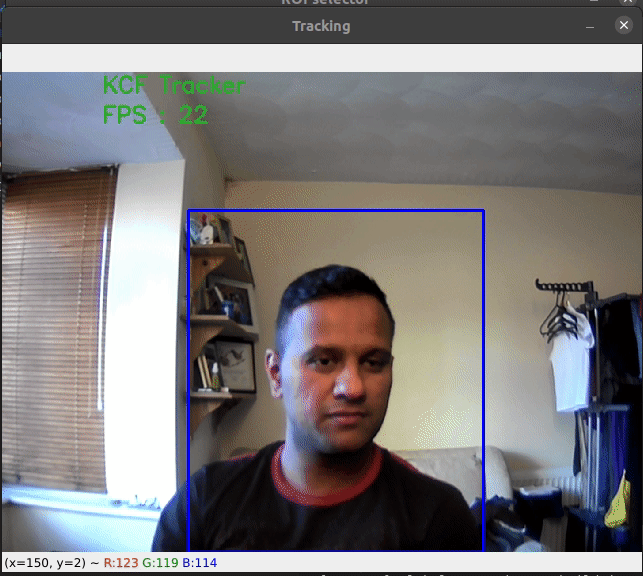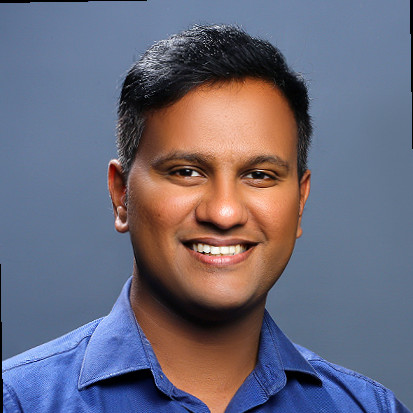Visual Object Tracking
![]()
Introduction to Visual Object Tracking (VOT)
In this article, we will look at what does it mean by Visual Object Tracking. Also, we will implement a simple visual object tracking algorithm (namely Kernelized Correlation Filter) using Python to track any random object of our choice via our computer webcam.

Jargon Buster for Visual Object Tracking
When you dive into the field of visual object tracking, often you will across few jargons. I think it would be beneficial to define those terms at the start of the article. Below are few words:
- Sequence: A sequence is nothing but a video
- Frame: Any sequence or video is made up of a number of images. Such an image is commonly termed as a frame. So, we can say that a sequence is made up of multiple frames.
- Tracker: There are various algorithm developed to track an object in various frames from a sequence. When such algorithm is implemented to track any object, it is commonly referred as a ‘visual object tracker’. Sometimes, the algorithm is also known by the term ‘tracking algorithm’.
Visual Object Tracking
Visual Object Tracking is a process by which an algorithm locates an object in every frame of a sequence. Some of the real-world applications include tracking of vehicles, environmental surveillance, delivery of objects using drone etc,. Depending on the number of objects tracked by the algorithm in each frame, object tracking is classified into - Single Object Tracking (SOT) annd Multiple Object Tracking (MOT).
![]()
But how does the algorithm know which object to track?. This information is passed mainly by two ways:
- use an object detector to detect object or objects automatically from the first frame. The major downside of this approach is that whenever you need to track a different type of object/s (say, human instead of a car) you need to ensure that the object detector is trained to detect the new object type/s.
- user selects the object/s to be tracked in the first frame of the sequence. The object/s is usually selected by the user in the form of a rectangular box encompassing the target object as shown in below figure [1].
![]()
There are several state-of-the-art algorithms developed for Object Tracking. Some of them are:
- Kernelized Correlation Filters (KCF)
- Generic Object Tracking Using Regression Networks (GOTURN)
- Multiple Instance Learning(MIL)
- Minimum Output Sum of Squared Error (MOSSE)
- Spatio-Temporal trAnsfoRmer network for visual tracKing (STARK)
In this article, we will mainly focus on Single Object Tracking using KCF algorithm.
Single Object Tracking
KCF algorithm utilises the concept of correlation filter. The underlying principle is that when two samples or values are correlated then the correlation value is higher and vice-versa. This principle is extended to calculate the correlation value between the image patch containing the target object in the previous frame and the image patch from the future frame. The higher correlation value indicates the patch from the future frame where the target object is likely to be found. If you are interested to find more about KCF, it is worth to read the original research paper from the authors of KCF.
Now let’s implement the KCF algorithm using Python Open CV library. First, let us install the open cv library using below pip or conda command.
pip install opencv-python
Or
` conda install -c conda-forge opencv `
Import Open CV library
# Import the cv2 library
import cv2
print("The open cv version is:", cv2.__version__)
The output is shown as below.
The open cv version is: 4.5.1
The remaining code is shown below:
if __name__== "__main__":
# Create KCF algorithm
tracker = cv2.TrackerKCF_create()
# Use 0 to capture from web cam otherwise give the path to an input video
video = cv2.VideoCapture(0)
# Read the first frame
ok, frame = video.read()
'''
Select ROI enables to draw a rectangular box around the target from the first frame.
Press enter to continue.
'''
bbox = cv2.selectROI(frame, False)
# Initialses the KCF tracker with the target object bounding box
ok = tracker.init(frame, bbox)
while True:
# Read next frame from the webcam
ok, frame = video.read()
# if something goes wrong then break the loop
if not ok:
break
# Timer to calculate Frame Per Second (FPS)
timer = cv2.getTickCount()
# Update the KCF tracker with the new current frame
ok, bbox = tracker.update(frame)
# Calculate the FPS
fps = cv2.getTickFrequency() / (cv2.getTickCount() - timer)
if ok:
# Extract the bounding box co-ordinates from the KCF tracker
# p1 denotes the top left x and y co-ordinates
p1 = (int(bbox[0]), int(bbox[1]))
# bbox[2] and bbox[3] represents the width and height of the bounding box resp.
# p2 represents the bottom right x and y co-ordinates of bounding box
p2 = (int(bbox[0] + bbox[2]), int(bbox[1] + bbox[3]))
# Draw the resulting bounding box on the current frame
cv2.rectangle(frame, p1, p2, (255,0,0), 2, 1)
else:
cv2.putText(frame, "Tracking failure detected", (100,80), cv2.FONT_HERSHEY_SIMPLEX, 0.75,(0,0,255),2)
# Display tracker type on frame
cv2.putText(frame, "KCF Tracker", (100,20), cv2.FONT_HERSHEY_SIMPLEX, 0.75, (50,170,50),2)
# Display FPS on frame
cv2.putText(frame, "FPS : " + str(int(fps)), (100,50), cv2.FONT_HERSHEY_SIMPLEX, 0.75, (50,170,50), 2)
cv2.imshow("Tracking", frame)
# Exit if ESC pressed
k = cv2.waitKey(1) & 0xff
if k == 27 : break
You can play around with the code. Try using other tracking algorithms such as GOTURN etc. Record your observations for the below questions:
- Is it faster than KCF?
- Does it fail under any conditions such as low lighting, fast moving target etc?
- Is the tracking good enough to be acceptable for a real world applications?
Have you got any suggestions? - Please reach out to me. I would love to hear it.
References
[1] Chen BX, Tsotsos JK. Fast visual object tracking with rotated bounding boxes. arXiv preprint arXiv:1907.03892. 2019 Jul 8
